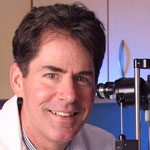Pediatric ophthalmologist R. Lawrence Tychsen, MD, has been named the John F. Hardesty, MD, Distinguished Professor of Ophthalmology and Visual Sciences at Washington University School of Medicine in St. Louis.
Chancellor Mark S. Wrighton and Larry J. Shapiro, MD, executive vice chancellor for medical affairs and dean of the School of Medicine, announced the appointment. Tychsen will be installed May 31.

“Dr. Tychsen’s extraordinary dedication to children with severe visual impairments makes him an excellent selection for this professorship to honor the legacy of Dr. Hardesty,” Wrighton says. “During his more than 20 years at Washington University, Dr. Tychsen’s work has given his patients a better future, and we are pleased to honor his outstanding work this way.”
“Through his surgical techniques and incredible compassion, Larry Tychsen has changed the lives of many visually impaired children and their families,” Shapiro says. “This professorship will provide support for Larry to continue his research and his development of new treatments for ocular disorders.”
Since many of his patients have difficulty communicating or being examined, Tychsen has established the Amblyopia and Eye Movement Disorders Center and Visual Electrophysiology Laboratory at St. Louis Children’s Hospital, where he is ophthalmologist-in-chief. In the laboratory, he and his team use noninvasive electronic techniques to measure patients’ eyesight before, during and after surgery. A computer allows precise measurement of visual acuity and eye tracking, which can help determine whether a child has a problem with sensory input or motor output.
Tychsen, professor of ophthalmology and visual sciences, of pediatrics and of anatomy and neurobiology, earned an undergraduate degree in biology and philosophy and a medical degree from Georgetown University. After medical school, he completed a one-year fellowship in neuro-ophthalmology at the National Eye Institute within the National Institutes of Health (NIH). He completed a residency at the University Hospitals in Iowa City, Iowa, followed by fellowships at the University of California, San Francisco, and the Smith-Kettlewell Eye Research Institute in San Francisco. He also served in the U.S. Air Force as a flight surgeon and pediatric ophthalmologist at the School of Aerospace Medicine and the Wilford Hall Medical Center in San Antonio, Texas, before joining the faculty at Washington University School of Medicine in 1989.
Tychsen has published more than 200 peer-reviewed journal articles or book chapters. He serves on the editorial boards of several journals, as well as panels for national and international ophthalmology associations, the National Eye Institute of the NIH and the Pediatric Eye Disease investigator group, and is a consultant to the U.S. Food and Drug Administration. He has mentored numerous undergraduate and medical students over his career and has received dozens of awards, lectureships and honors. He also treats patients at Missouri Baptist Hospital and Shriner’s Hospital for Children in St. Louis.
John F. Hardesty, MD (1887-1953), was a St. Louis ophthalmologist, teacher, writer, and war hero whose heritage may be traced back to colonial and early Missouri settlers. He earned bachelor’s and medical degrees simultaneously from Saint Louis University in 1914, then spent two years as an intern and later a resident at St. Louis City Hospital.
Hardesty’s daughter, Jane Hardesty Poole, a 1961 graduate of Washington University, established the John F. Hardesty, MD, Distinguished Professorship in Ophthalmology and Visual Sciences in his honor.
“My father gave so much of himself to help families desperate to give their blind children sight,” Poole says. “I am so pleased that I can honor him in this way.”
Hardesty enlisted in the U.S. Army Medical Corps and was later transferred, at his own request, to the Seaforth Highlanders in the British Military Service. He served on the front lines of World War I until March 1918, when he was captured by the German army and held at Baden-Baden for eight months as a prisoner of war until the armistice. He received an honorable discharge as a captain in March 1919.
Hardesty joined the Saint Louis University School of Medicine faculty in 1920, and rose through the ranks to associate professor in 1934, a position he held until 1953. He served as acting chair of the Department of Ophthalmology from 1950-53.
In 1934, Hardesty wrote a pioneering thesis for membership in the prestigious American Ophthalmological Society titled “Treatment of Glaucoma by Systemic Measures.” Although the first recorded treatments for glaucoma date back to the mid-19th century, Hardesty performed research and published papers on treating the disease using “systemic” medication, or drugs introduced to the body intravenously or subcutaneously. This represented the first attempt to treat glaucoma in systemic form.
Hardesty’s idea of using epinephrine to treat glaucoma is still in use today, and his work laid the foundation for the development of the oral drug Diamox (acetazolamide) in the 1950s by Bernard Becker, MD, at Washington University School of Medicine.
In addition to his university roles, Hardesty was ophthalmologist to the St. Louis City Sanitarium from 1921-1953 and ophthalmologist-in-chief at Missouri Baptist and Bethesda General hospitals, as well as a member of the Medical Advisory Board for the State of Missouri. He also served as medical director for the St. Louis Society for the Blind.
Washington University School of Medicine’s 2,100 employed and volunteer faculty physicians also are the medical staff of Barnes-Jewish and St. Louis Children’s hospitals. The School of Medicine is one of the leading medical research, teaching and patient care institutions in the nation, currently ranked sixth in the nation by U.S. News & World Report. Through its affiliations with Barnes-Jewish and St. Louis Children’s hospitals, the School of Medicine is linked to BJC HealthCare.